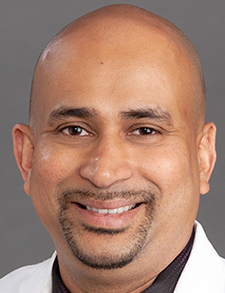
Dr. Thazhatuveetil-Kunhahamed
Clinical Question: Is extended rivaroxaban prophylaxis (10 mg daily for 35 days) protective against arterial and venous thromboembolism (VTE) events in COVID-19 patients with high-risk features during the post-hospitalization period?
Background: Multiple studies have demonstrated an increased risk of thrombosis in patients suffering from a severe SARS-CoV-2 infection. Post-discharge VTE, arterial thromboembolism, and all-cause death following hospital discharge in COVID-19 patients have been reported to be approximately 7%. Preliminary data reported a 46% reduction in VTE in patients prescribed prophylactic anticoagulation on discharge. However, there remains no consensus on the role of post-hospital discharge prophylactic anticoagulation.
Study Design: Pragmatic, open-label (with blinded adjudication), multi-center, randomized, controlled trial with intention-to-treat analysis
Setting: 14 hospitals in Brazil from October 8, 2020 to June 29, 2021
Synopsis: 320 adult patients with COVID-19 and high risk for VTE based on a moderate/high IMPROVE VTE risk score (>2) plus an elevated D-dimer level (>500 ng/dL) were included. On discharge, patients were randomly assigned to receive either rivaroxaban (10 mg daily) for 35 days or no anticoagulation. All patients were hospitalized for more than three days, received standard-dose thromboprophylaxis with heparin while hospitalized, and received bilateral lower-extremity venous ultrasound and CT pulmonary angiography at 35 days post-discharge. Patients with general contraindications to anticoagulation or a major bleeding risk were excluded. 52% of patients had intensive-care-unit stays during their hospitalization. 159 patients from each group were included in the intention-to-treat analysis and the primary outcome (symptomatic or asymptomatic VTE or arterial embolism or cardiovascular-related death) was significantly lower in the rivaroxaban group than in the no-anticoagulation group (3.14% versus 9.43%; number needed to treat, 16). Also, there was a reduced rate of symptomatic/fatal VTE in the rivaroxaban group than in the no-anticoagulation group (0.63% versus 5.03%). No major bleeding events occurred in either group.
Bottom Line: In select high-risk patients recovering from COVID-19, rivaroxaban 10 mg for 35 days post-discharge may decrease VTE events and related mortality without a significant increase in major bleeding.
Citation: Ramacciotti E, et al. Rivaroxaban versus no anticoagulation for post-discharge thromboprophylaxis after hospitalization for COVID-19 (MICHELLE): an open-label, multicentre, randomized, controlled trial. Lancet. 2022;399(10319):50-59. doi:10.1016/S0140-6736(21)02392-8.
Dr. Thazhatuveetil-Kunhahamed is an assistant professor of internal medicine at Wake Forest School of Medicine, Winston-Salem, N.C